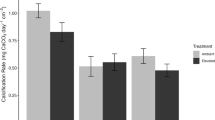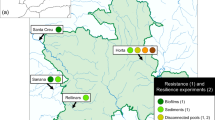Abstract
Three species of the marine wood-boring genus Limnoria were subjected to low dissolved oxygen concentrations at different temperatures under laboratory conditions. 28-day median tolerance limits (TLm) were 1.0 mg/l of dissolved oxygen at 15° to 16°C and 19° to 20°C for L. lignorum, 0.75 and 0.60 mg/l at 15° to 16°C and 22° to 25°C, respectively, for L. quadripunctata, and 1.0 and 1.18 mg/l at 15° to 16°C and 22° to 25°C, respectively, for L. tripunctata. The amount of burrowing activity, as measured by the egestion rate, was directly related to the amount of dissolved oxygen. A daily egestion rate of 0.116 mg per day in L. tripunctata at 22° to 25°C was the highest figure measured. The daily egestion rate was sharply reduced at dissolved oxygen concentrations below 3.0 mg/l.
Similar content being viewed by others
Literature cited
Becker, G., u. W. D. Kampf: Die Holzborasseln der Gattung Limnoria (Isopoda) und ihre Lebensweise, Entwicklung und Umweltabhängigkeit. Z. Angew. Zool. 42, 422–517 (1955).
Clapp, W. F.: Increase of the destruction of timber structures by marine wood borers in New England waters. Proc. Amer. Wood-Preservers Assoc. 13, 167–169 (1935).
Clapp, W. F.: Marine borers in the North Atlantic. Conn. Soc. Civil Engin. Ann. Rept. 52, 87–97 (1936).
Doochin, H., and F. G. W. Smith: Marine boring and fouling in relations to velocity of water currents. Bull. mar. Sci. Gulf Carib. 1, 196–208 (1951).
Eltringham, S. K.: Wood-boring activity of Limnoria (Isopoda) in relation to oxygen tension. Nature, Lond. 190, 512–513 (1961a).
—: The effect of salinity upon the boring activity and survival of Limnoria (Isopoda). J. mar. Biol. Assoc. U.K. 41, 785–799 (1961b).
—: The effect of temperature upon the boring activity and survival of Limnoria (Isopoda). J. Appl. Ecol. 2, 149–157 (1965).
Henderson, J. T.: The Gripple: A study of the distribution factors and life history of Limnoria lignororum at St. Andrews, N.B. Canadian Biol. N.S. 2, 307–326 (1924).
Isham, L. B., F. G. W. Smith, and V. Springer: Marine borer attack in relation to conditions of illimination. Bull. mar. Sci. Gulf Carib. 1, 46–63 (1951).
Mawatari, S.: Analytical study of various methods for the protection of wooden ships against marine borers. Inst. Nat. Resources, Misc. Rept. 13, 17–30 (1949).
Menzies, R. J.: The marine borer family Limnoriidae (Crustacea, Isopoda). Bull. mar. Sci. Gulf Carib. 7, 101–200 (1957).
—, and J. L. Mohr: The occurrence of the wood-boring crustacean Limnoria and of Nebaliacea in Morro bay, Calif. Wasmann J. Biol. 10, 81–86 (1952).
—, and C. M. Wakeman: The seasonal settlement of wood-borers in Los Angeles-Long Beach harbors. Wasman J. Biol. 21, 97–120 (1963).
Nair, N. B., and H. Leivestad: Effect of low temperature on the vertical distribution of two wood-boring crustaceans. Nature, Lond. 182, 814–815 (1957).
O'Keefe, F. J.: The use of treated timber in port structures in New York harbor. Proc. Amer. Wood-Preservers. Assoc. 31, 164–167 (1935).
Quayle, D. B.: Dispersal of introduced marine-borers in British Columbia water. C. r. Congr. int. Corros. mar. Saliss. (Cannes) pp. 409–412 (1964).
Reish, D. J.: Polychaetous annelids as associates and predators of the crustacean wood-borer, Limnoria. Wasman J. Biol. 12, 233–226 (1954).
Reish, D. J.: Relationship of polychaetes to varying dissolved oxygen concentrations. Third Int. Conf. Water Pollution Res., Munich. Sect. 3, paper 10, pp. 1–10 (1966).
—, and J. L. Barnard: Field toxicity tests in marine waters utilizing the polychaetous annelid Capitella capitata (Fabricius). Pacific. Nat. 1 (21), 1–8 (1960).
—, and T. L. Richards: A technique for studying the effect of varying concentrations of dissolved oxygen on aquatic organisms. Int. J. Air Wat. Pollut. 10, 69–71 (1966).
Wakeman, C. M., and H. Schiller: The marine-borer problem in Los Angels harbor. In Proc. Wrightsville Beach Mar. Conf., National Res. Council Publ. 203, 19–25 (1951).
—, and L. L. Whiteneck: Extending service life of wood piles in sea water. Spec. Publs. Amer. Soc. test. Mater. 275, 15–21 (1959).
Author information
Authors and Affiliations
Additional information
Communicated by G. L. Voss, Miami
Rights and permissions
About this article
Cite this article
Anderson, J.W., Reish, D.J. The effects of varied dissolved oxygen concentrations and temperature on the wood-boring isopod genus Limnoria . Marine Biol. 1, 56–59 (1967). https://doi.org/10.1007/BF00346695
Accepted:
Issue Date:
DOI: https://doi.org/10.1007/BF00346695




